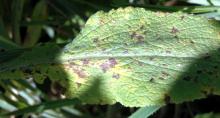See:
Foxglove (Digitalis spp.) - Anthracnose
Cause Fungi: Ramularia variabilis reported from Washington and Oregon; Colletotrichum fuscum, reported from Oregon; and Septoria digitalis, reported from British Columbia. They are favored by wet, rainy conditions. Septoria may be seedborne. Leaf spots are typically favored by warm wet conditions.
Symptoms Round to irregular, white to brown spots up to 0.25 inch in diameter with red to purple borders. Lower and older leaves are most severely affected and may shrivel and die. Ramularia infections are characterized by tufts of white conidia growing out of stomata in the leaves. Septoria infections exhibit tiny black pycnidia, which extrude tendrils of spore masses under wet conditions.
Cultural control
- Collect and destroy crop residue after harvest.
- Practice crop rotation.
- Avoid dense plantings, and time irrigation to minimize the time leaves are wet.
- Home gardeners may find it helps to remove affected leaves.
Chemical control
- Seed treatment with captan or thiram is recommended in British Columbia where Septoria is a problem.
- Spray a foliar fungicide on overwintered crops in fall and spring.
- Fixed-copper products. Group M1 fungicide. O
- Heritage at 1 to 4 oz/100 gal water plus a non-silicone-based wetter sticker. Group 11 fungicide. 4-hr reentry.
- Insignia SC at 3 to 6 fl oz/100 gal water. Do not use with organosilicate-based adjuvants. Use preventively only. Group 11 fungicide. 12-hr reentry.
- OHP 6672 4.5 F at 10 to 14.5 fl oz/100 gal water plus another fungicide. Group 1 fungicide. 12-hr reentry.
- Although not specifically registered for foxglove, IR-4 data indicate that products containing iprodione (Chipco 26019) are safe on this crop. These products may be helpful against some or all of these leaf spots.
Reference Pirone, P.P. 1978. Diseases and Pests of Ornamental Plants, 5th ed. New York: John Wiley & Sons, Inc.

